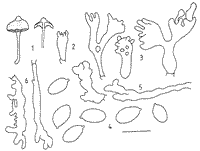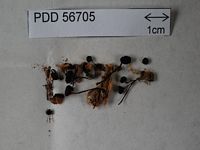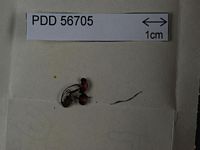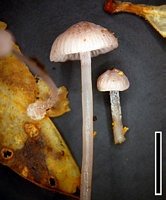|
 Mycena oratiensis Mycena oratiensis
BiostatusPresent in region - Indigenous. Endemic
Images (click to enlarge)
Caption: Fig. 5. M. oratiensis. 1. basidiomes. 2. basidium. 3. cheilocystidia. 4. basidiospores. 5. pileipellis elements. 6. terminal cells of stipe. | 
Caption: Dried type specimen
Owner: Herb PDD | 
Caption: Dried type specimen
Owner: Herb PDD | 
Caption: FUNNZ2007/1246
Owner: FUNNZ | |
Article: Segedin, B.P. (1991). Studies in the Agaricales of New Zealand: some Mycena species in sections Longisetae, Polyadelpha, Rubromarginatae, Galactopoda, Lactipedes, and Calodontes. New Zealand Journal of Botany 29(1): 43-62 (http://www.rsnz.org/publish/abstracts.php).
Description: Pileus 6-15 (diam.)
X 10 mm, convex with a small "bubbly" umbo, mammiform, deep rose pink
to vinaceous (11D5 K&W), pellucid striate up to the umbo, smooth, drying
black. Lamellae deeply decurrent, arcuate, in 2 series with 14 long lamellae,
pale vinaceous (8B2) with a broad, dark red margin, still conspicuous in dried
material. Stipe 15-22 X 1-1.5 mm, even, with slight swelling towards the base,
concolorous with pileus, smooth and shining, exuding some watery juice when
broken. Smell and taste unknown.
Colour of spore
print unknown. Spores 7.5-9.5 X 4.5-5.5(8.4 X 4.8) µm., Q= 1.75, ellipsoid,
hyaline, amyloid, thin-walled. Basidia 25 X 6 µm. with 4 relatively long sterigmata
(5 X 2 µm.), bright yellow in Melzer's. Cheilocystidia 30-45 µm. long, very
abundant, forming a very broad zone at the lamellar edge and extending over
the face of the lamella, dendrophysoid, narrow or swollen basally, giving rise
apically to several short, nodulose outgrowths or more complicated, stout, branching
systems, thin-walled, with red plasmatic pigment. Pleurocystidia absent. Trama
of more or less parallel, narrow (5 µm.) to inflated (20 µm.) hyphae with clamp
connections and a few narrow conducting elements. Subhymenium cellular. Both
tissues weakly vinaceous brown in Melzer's. Pileipellis a repent epicutis of
narrow (5-7 µm.) nodulose-diverticulate hyphae, with reddish plasmatic pigment.
Subpellis of inflated (up to 20 µm. diam.) hyphae also with red plasmatic pigment.
Stipe covered with nodulose-diverticulate hyphae like the pileipellis. Clamp
connections present.
Habitat: HABITAT: On wood in kauri (Agathis australis Salisb.)
forest.
Notes: ETYMOLOGY: named after the district (Oratia) in which
the species was first discovered.
The umbonate, brightly
coloured, pellucid striate pileus, decurrent to arcuate lamellae with a strongly
pigmented margin and lignicolous habit are characteristic of this fungus. The
nodulose pileipellis elements and the only faintly vinaceous (in Melzer's) staining
of the trama are rather unusual features for section Rubro-marginatae. It resembles
M. seynesiella Malencon apud Mal. & Bertault in having coralloid
pileipellis elements but its cheilocystidia are diverticulate rather than smooth
lageniform as in M. seynesiella.
|